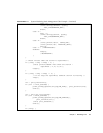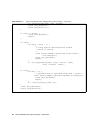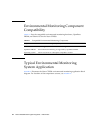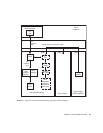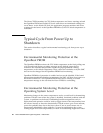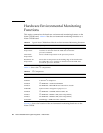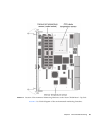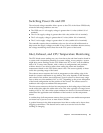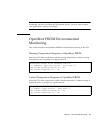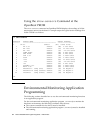
Chapter 2 Environmental Monitoring 27
Protection at the operating system level takes place when the PICL environmental
monitoring program (envmond) is running. The environmental monitoring program
is part of a UNIX daemon that runs automatically when the Solaris OS boots up.
In a typical environmental monitoring application program, the software reads the
CPU, inlet, and exhaust temperature sensors once every polling cycle. The program
then compares the measured CPU diode temperature with the warning temperature
and displays a warning message on the default output device whenever the warning
temperature is exceeded.
The program can also issue a shutdown message on the default output device
whenever the measured CPU diode temperature exceeds the shutdown temperature.
In addition, the envmond application program can be programmed to sync and shut
down the Solaris OS when conditions warrant.
Refer to “Sample Application Program” on page 37 for an example of how a simple
envmond program can be implemented.
The power module is controlled by the SMC subsystem, except for automatic
controls such as overcurrent shutdown or voltage regulation. The functions
controlled are core voltage output level, and power sequencing and monitoring.
Post Shutdown Recovery
The on-board voltage controller is a hardware function that is not controlled by
either firmware or software. At the OpenBoot PROM level, if the board temperature
exceeds the shutdown temperature, the SMC will shut down power to the Netra
CP2500 CPU.
There is no mechanism for the Solaris OS to either recover or restore power to the
Netra CP2500 when an unusual condition occurs, for example, if the CPU diode
temperature exceeds its maximum recommended level. In either case, the end user
must intervene and manually recover the Netra CP2500 as well as the system
through hardware control. Once a shutdown has occurred, you can recover the
board using a cold-reset IPMI command to SMC or by extracting and reinserting the
board.



